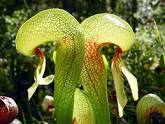











CAJEPUT- Melaleuca cajeputi
Family: Myrtaceae
Synonyms M. minor, cajuput, white tea tree, white wood, swamp tea tree, punk tree, paperbark tree.
General Description
A tall evergreen tree up to 30 metres high, with thick pointed leaves and white flowers. The flexible trunk has a whitish spongy bark which flakes off easily. In Malaysia it is called 'caju-puti', meaning 'white wood', due to the colour of the timber.
Distribution: It grows wild in Malaysia, Indonesia, the Philippines, Vietnam, Java, Australia and South eastern Asia.
Other Species
Several other varieties of Melaleuca are used to produce cajeput oil, such as M.quinquenervia- see Botanical Classification section. Closely related to other members of the Melaleuca group, notably Eucalyptus, clove, niaouli and tea tree.
Herbal and Folk Tradition
Held in high regard in the East, it is used locally for colds, headaches,throat infections, toothache, sore and aching muscles, fever (cholera0, rehumatism and various skin diseases. Only the oil is used in the Western herbal tradition, known for producing a sensation of warmth and quickening the pulse.
It is used for chronic laryngitis and bronchitis, cystitis, rehumatism and to expel roundworm.
Actions
Mildly analgesic, antimicrobial, antineuralgic, antispasmodic, antiseptic (pulmonary, urinary, intestianl), anthelmintic, diaphoretic, carminative, expectorant, febrifuge,insecticide, sudorific, tonic.
Extraction
Essential oil by steam distillation from the fresh leaves and twigs.
Characteristics
A pale yellowy-green, mobile liquid (the green tinge from traces of copper found in the tree) with a penetrating, camphoraceous-medicinal odour. Compared with Eucalyptus oil, it has a slightly milder fruity body note.
Principal Constituents
Cineol (14-65 per cent depending on source), terpineol, terpinyl acetate, pinene, nerolidol and other traces.
Safety Data
Non-toxic, non-sensitizing, may irritate the skin in high concentration.
Aromatherapy Home Use
Skin care: Insect bites, oily skin, spots.
Circulation muscles and Joints: Arthritis,muscular aches and pains, rehumatism.
Respiratory system: Asthma, bronchitis, catarrh, coughs, sinusitis, sore throat.
Genito-Urinary system: Cystitis, urethritis, urinary infection.
Immune system: Colds, 'flu, viral infections.
Other Uses: Used in dentistry and pharmaceutical work as an antiseptic; in expectorant tonic formulations, throat lozenges and perfumes. Occasionally employed as a flavour component in food products and soft drinks.
Reference: The Encyclopedia of Essential Oils: Julia Lawless
Articles Latest
- Chamomile Roman - Chamaemelum nobile
- Chamomile Maroc - Ormenis multicaulis
- Chamomile German - Matricaria recutica
- From Biology To Aromatherapy
- Plant Messengers
- Celery Seed-Apium graveolens
- Cedarwood Virginian - Juniperus virginiana
- Cedarwood, Texas- Juniperus ashei - Essential oils
- Cedarwood Atlas- Cedrus atlantica - Essential Oils
- Cassie - Acacia Farnesiana - sweet acacia
- Cassia - Cinnamomum Cassia
- Cascarilla Bark - Croton eluteria
- Carrot Seed- Dacus Carota
- CARDAMON
- CARAWAY
- CANANGA
- CAMPHOR
- CALAMUS
- Calamintha-Calamintha officinalis
- CAJEPUT- Melaleuca cajeputi
- Plant Expression
Articles-Most Read
- Home
- Balsam Canadian - Abies balsamea
- Balsam Peru
- Copaiba Essential Oil
- North America: Tea Tree and Monarda-3
- Basil French - Ocimum basilicum
- Basil Exotic
- North America: Tea Tree and Monarda-2
- Exploring Transcultural Constants
- Thyme Essential Oil
- Balsam Tolu
- Palma Rosa
- Bay - West Indian - Pimenta racemosa
- The Bioactivity of Essential Oils
- Benzoin - Styrax benzoin
- Why Pharmacology Cannot Demonstrate Essential Oil Efficacy
- Exploring Essential Oil Activity The Conventional Way
- Complex information From Plants
- Aromatherapy: An Answer
- Contacts
